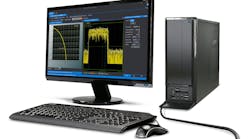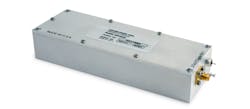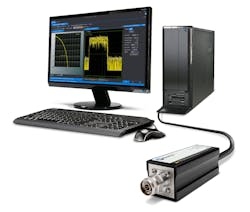A New Approach to Over-the-Air Production Test
Approximately 1.5 billion mobile phones are sold each year—and that quantity is expected to continue for the foreseeable future. With such high volumes, it’s critical to have fast, cost-effective production test capability.
However, the technologies needed to meet the requirements for 5G communication systems are challenging manufacturers like never before. 5G devices are operating at higher frequencies, which require smaller geometries and incorporate even greater levels of component integration, making it nearly impossible to utilize conducted RF testing in production. Add to this the incorporation of increasingly sophisticated multiple-input, multiple-output (MIMO) technology and utilization of beamsteering techniques, it’s clear that over-the-air (OTA) testing has never been more important. But historical implementations of OTA testing are complicated, expensive, and slow.
This article introduces a new approach to OTA production test. It utilizes a noise source to stimulate the device under test (DUT) with a signal that’s an accepted surrogate to a high sub-carrier orthogonal-frequency-division-multiplexed (OFDM) signal. In addition, a peak power meter (or USB sensor) is used to more accurately determine signal distortion caused by amplifier compression. The result is a new approach that’s faster, simpler, and more cost-effective (Fig. 1).
1. This new approach to OTA production test is quicker and simpler than other test methods.
Current Challenges Associated with OTA Testing
Traditionally, RF performance of devices like mobile phones was optimized using OTA and conducted tests in the research-and-development phase. When manufacturing these devices, production was performed utilizing primarily conducted RF testing supplemented with offline OTA sample testing.
However, as these devices move to higher frequencies and greater levels of integration, it may no longer be possible to perform conducted measurements. Couple this with the increasing performance requirements on these devices for 5G communications, such as more sophisticated MIMO technology and beamsteering to help meet the demand for higher data rates, and all roads lead to the need for OTA testing.
OTA Methodologies Being Considered
Starting with the distance at which the measurements will be made, three OTA techniques are being considered: direct far field, indirect far field (using compact ranges), and near field (utilizing a near-field to far-field transformation). The type of signals to be used must then be determined.
For simpler applications, such as characterizing a single-element antenna, vector network analyzers (VNAs) have been the instruments of choice. When more complex parameters must be measured, instruments like vector signal generators (VSGs) and vector signal analyzers (VSAs) are often used. For complete end-to-end analysis, engineers generally turn to instruments that can emulate a mobile phone or base station.
In research-and-development applications, only a small amount of OTA chambers is needed. Higher costs for doing various tests can be tolerated. The same can be said for traditional offline performance verification. Today’s challenge is that OTA must be performed as part of the in-line manufacturing process.
Taking Manufacturing OTA Testing on a Different Path
A concept being explored involves device manufacturers performing extensive testing in research and development using the methods described. With a thorough understanding of device performance, they will only need to conduct performance verification OTA testing in production. Moreover, they will want to do it in the most cost-effective, time-efficient, and simplest way.
Using a mobile phone or base-station emulator is very expensive and time-consuming. Using a VNA is still expensive and only provides verification with a continuous-wave (CW) signal, which is not representative of the environment that the devices will reside in. With 4G, 5G, and Wi-Fi 6 including thousands of sub-carriers, a CW verification process may not provide sufficient information to correlate how the devices will function with a multi-tone signal. On top of that, VNAs are complicated to use.
In the proposed new approach, manufacturers would use noise sources to stimulate their devices. Extensive research has shown how a noise source provides an excellent signal to simulate the multi-tone signals used in actual operation. When employing noise sources like the Noisecom NC1000 series, manufacturers can provide a 100-MHz additive white Gaussian noise (AWGN) signal to stimulate their devices with a 5G representative signal (Fig. 2). These noise sources are a fraction of the price of a VSG or radio emulator, and they are very fast and easy to use.
2. Noisecom’s NC1000 series of amplified AWGN noise modules produce AWGN as high as +13 dBm.
AWGN sources can generate broadband OFDM-like signals at a wide variety of frequencies, including millimeter-wave (mmWave) frequencies with MHz to GHz signal bandwidths, much more cost-effectively than alternatives. Crest factors (peak-to-average powers) can be generated and varied in excess of 10 dB, and power levels can be varied for wide dynamic ranges. With these capabilities, noise sources are not only ideal for stimulating devices, but also an excellent tool for characterizing and calibrating the system response within the anechoic chamber used to make the OTA measurements.
Peak Power Measurement is Key
For the measurement, peak power meters are proposed. The most common instruments for measuring RF power are average power meters. However, in this application, average power measurements do not provide a complete picture of the device performance. Because the devices will be used with multi-tone signals, the signal will have a high crest factor: It’s not uncommon for these signals to have crest factors in the 10- to 15-dB range. If a device is not behaving as intended, an average power reading may not tell the whole story.
For example, an average power measurement may show that amplifier is in compression by a small, tolerable amount and would not reveal what’s happening to peak power due to modulation or intermodulation products. In many instances, it’s possible to have less than 0.1 dB of compression in average power, while the crest factor compresses by 1 dB or more. Compression of 0.1 dB may be tolerable, but perhaps not so much with a value greater than 1 dB.
For this reason, it’s crucial that a peak power meter be used—and it must have sufficient video bandwidth (VBW). The Boonton RTP5006 real-time peak power meter offers up to 195-MHz VBW, which is more than sufficient to measure 100-MHz 5G channels (Fig. 3). The next closest competitor USB peak power meter has 30-MHz VBW.
3. Boonton’s RTP5000 series of real-time peak USB power sensors achieve up to 195-MHz VBW.
Peak power meters are simple to use, fast, and a fraction of the price of a VSA or radio emulator. They also have much lower measurement uncertainty than analyzers and radio emulators. Multiple sensors can be placed throughout the OTA test chamber and synchronized for measuring average and peak power to characterize device beamsteering and directivity performance.
Summary
With the sheer volume of wireless devices like mobile phones being produced every year, fast and cost-effective product test solutions are essential. The movement to higher frequencies and greater levels of integration coupled with utilization of increasingly sophisticated MIMO technology as well as beamsteering techniques in 5G technologies mandates that OTA testing be incorporated into the manufacturing process.
Traditional OTA testing approaches are too slow, expensive, and complicated to implement. To overcome those issues, a new approach to OTA test for manufacturing applications uses easy-to-use, fast, and cost-effective noise sources and peak power USB sensors.
Walt Strickler is VP and GM of Boonton Electronics, Matt Diessner is Director of Business Development at Wireless Telecom Group, and Dr. Lee McMillan is Director of Engineering at Noisecom.




